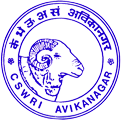Technologies developed by CSWRI
Establishment of elite flocks
The institute has well developed sheep flocks of Malpura (750), Chokla (550), Avikalin (350), Patanwadi (100), Patanwadi crosses (200), Garole (40), Kendrapada (100) and Garole crosses (300) for genetic improvement and other technology development.
Improved germplasm developed
Malpura, a promising breed for mutton production
 Malpura Ram
Malpura Ram
Malpura, an indigenous sheep for mutton has been improved through intensive selection. Body weight at six month of age has been improved from 13.84 kg in 1974-75 to 25.74 kg in 2010-11. High genetic merit rams are being supplied to the farmers for genetic improvement of animals in the breed tract. The improvement in the farmer’s flock was 7.63 and 14.92 per cent at 6 month’s body weight and in first six monthly greasy fleece yield (GFY), respectively.
Chokla, best carpet wool breed
 Chokla ram
Chokla ram
Chokla sheep has been improved through intensive selection for fine carpet wool production. It
produces 2.4 kg wool per annum with average fiber diameter of around 30m and medullation of around 30%. The staple length of more than 6.0 cm makes it ideally suitable for carpet
Prolific sheep
 Prolific crossbred ewe with triplet
Prolific crossbred ewe with triplet
Highly prolific sheep were created by introgression of
FecB gene from Garole sheep into the non-prolific and large sized mutton breed Malpura. In GMM crosses multiple births has reached to 40% as compared to single births in Malpura. Increased prolificacy will boost the total mutton production in the country.
Technologies developed
Artificial insemination (AI) in sheep with liquid semen
 AI in sheep at farmer’s door
AI in sheep at farmer’s door The technique for AI in sheep using liquid semen has been developed. AI has direct impact on the production level of the progeny and improves the desirable production traits like body weight, wool quantity and quality and fecundity in a very short span of time. This technology has been used both in organized farms and in farmer’s flock using semen of elite rams.
Indigenous intra-vaginal sponges for oestrus induction and synchronization
 Indigenous intra-vaginal sponges
Indigenous intra-vaginal sponges
Progesterone impregnated intra-vaginal sponges have been developed indigenously for oestrus induction and synchronization in sheep and goats. These sponges are being utilized for fertility management and artificial insemination programme. This technology has been commercialized. Till date more than 15000 sponges have been supplied to different agencies including ICAR and SAU institutes, State Government, KVKs, organized farms and NGOs.
Intensive lamb rearing for maximizing mutton production
 Intensive lamb rearing
Intensive lamb rearing
Intensive feeding protocols for lambs on (i) complete feed consists of roughage and concentrates mixture in ratio of 50:50 or (ii) free grazing and
ad libitum concentrate mixture supplementation for mutton production has been developed for attaining finishing weight of 33.0 kg at 6 month of age in lambs of native breeds. The venture is found to be economically viable and would boost mutton production in the country. This would also enhance income of the farmers engaged in sheep rearing practices.
Area-specific mineral mixture
 Mineral supplement powder form
Mineral supplement powder form
 Mineral Pellet supplements
Mineral Pellet supplements
Area specific mineral mixtures (ASMM) for cattle, buffaloes, sheep and goats of semi-arid region of Rajasthan have been developed for improving health, reproduction and production level. The ASMM is available in both pelleted and powder form. The later is having advantage of delivering the micronutrients in more complete and in quantifiable manner.
Complete feed block (CFB)
 Complete feed blocks
Complete feed blocks
The complete feed block of roughage and concentrate mixture was prepared in 70:30 ratios with 5.0% of molasses for easy binding. The blocks have many advantages like ease in transport, palatable in nature, lower in space requirement for storage and reduced losses during transport. Use of feed block to sheep and goat reduces the cost per kg gain by 38% as compared to the control diet (grass hay and concentrate). CFB reduces bulk density by 33% and can be stored up to 2 yrs in dry weather without deterioration in nutrients.
Planned flock health calendar for sheep flocks in semi-arid Rajasthan
 Flock Health Calendar
Flock Health Calendar
To reduce the losses caused by diseases in field flocks, an annual health calendar was developed through planned flock health approach following extensive studies on morbidity and mortality profile in field flocks of semi-arid Rajasthan. Prior to adoption of prophylactic health calendar the average mortality in farmer’s flocks was over 20% (1975-76), which was brought down to about 11% in 1985 and then further reduced to about 5%.
Modified worm management technology for sheep in Rajasthan

Gastrointestinal nematode (GIN) infections are an important cause of lost productivity in sheep of Rajasthan state. Farmers drench their animals with anthelmintics usually 2-3 times in a year coinciding with shearing operation. This practice of worm control resulted in failure of worm control programme due emergence of anthelmintic resistant strain of parasites throughout the state. Based on real time epidemiology of parasites, managemental (reproductive, grazing practices etc) and climatic conditions region based worm management programmes were formulated. The programme includes one strategic drench during mid to late monsoon and one need based tactical drench during autumn/winter. The programme saves Rs. 12 / sheep / annum compared to conventional drench schedule without compromising the flock productivity. Comparative evaluation of conventional (2-3 drench/annum) and modified technology (one drench/annum) in sheep naturally infected with GIN at farmer level yielded a net gain of Rs. 100.57 /sheep/yr as direct benefit on application of modified technology. Further, indirect benefits of technology are reduction in selection pressure on parasites, delaying the emergence of anthelmintic resistance and extending the life of existing anthelmintics.
Targeted selective treatment (TST) approach for management of haemonchosis in sheep
 Anaemia chart for haemonchosis in sheep
Anaemia chart for haemonchosis in sheep
To increase quantum of refugia and decrease in selection pressure for anthelmintic resistance through harvesting the benefits of over-dispersion in faecal egg count, targeted selective technique was developed for management of haemonchosis in sheep.
It is a simple system to categorize the anaemic status of sheep based on the conjunctiva mucosa colours on a scale from 1 (red) to 5 (white). Only those sheep categorized in group 4 / 5 were recommended for anthelmintic treatment particularly in wormy season. An average of 23% sheep in flock was given drench / annum through TST as against 100% in modified or 200-300% in convention approach. Direct benefit of TST application in sheep flock resulted in reduction in expenditure on anthelmintics from Rs. 7.0 to Rs. 0.81 / head / yr.
FROGIN: Software for forecasting gastrointestinal nematodiasis in sheep of Rajasthan
It is a computer based programme which simulates life cycle of
Haemonchus contortus in sheep and on pasture for different agroclimatic conditions of Rajasthan. This programme is capable of precisely forecasting the magnitude of parasitism for 60 days in advance and is extremely useful in decision making to organize deworming camps for sheep. Further, the programme is capable of shifting the scheduled drench in face of changing weather pattern and managemental modifications made by farmer. It’s implementation showed 70-80% similarity in predicted and observed intensity of strongyle infection in sheep flocks of Rajasthan.
Development of an ELISA for diagnosis of paratuberculosis (Johne’s Disease)
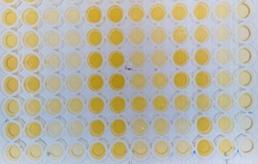
Diagnosis of Johne’s disease by ELISA
An ELISA for diagnosis of Johne’s disease developed and tested on natural sera of over 3000 small and large ruminant population in the country. The test has better sensitivity and over 95% specificity. The assay is rapid and easy to perform and can be used as screening test at organized farms as well as in field conditions. The detection of animals even several months before they die is a significant advantage for early removal of animals from the flock/herd to reduce further load of infection at the farm premises.
Carpet from indigenous wool and its blends
Indian wool is graded as best carpet type wool providing excellent resilience, lustre and performance. In order to improve the abrasion resistance, a process in which the wool is blended with 10% nylon fibre has been developed at CSWRI, Avikanagar.
Functional carpet
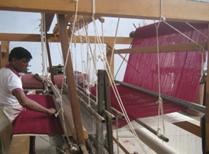
Handloom Weaving
The high productivity, low cost and profitable carpet manufacturing through handloom weaving has been introduced to weave plain and strips carpets for wall to wall covering. The technique has been standardized for important carpet parameters viz. pile height, pile density and ply of yarn.
Dying technology using natural dyes for wool and specialty fibres
Shawl dyed with natural dyes
The concern for the clean environment has created a deep interest in natural dyes. Several sources of natural dyes were screened for dyeing wool and specialty hair fibres. A comprehensive natural dyeing process is being standardized by which the wool can be dyed into all range of colours with good light and wash fastness properties.
Value added meat products developed from mutton
Value added meat products developed from mutton
 Meat product
Meat product
Diversified mutton products have been developed with a wide variety of flavors, textures, and shapes. Mutton nuggets are partially or completely emulsion based products, contain less fat. The mutton nuggets are also coated with suitable ingredients and then deep fat fried to give attractive golden brown color and to enhance palatability of the product. The other value added products prepared were sausages, petties, pickles, soap
enrobed eggs, muuton loaves and mutton kofta.
State of art facility
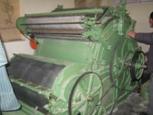
Dehairing cum Carding machine
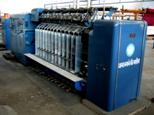
Spining machine
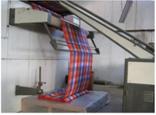
Blanket finishing

Amber Charka
A wool processing plant was commissioned at the institute under UNDP in 1968. The institute has complete set of machineries from scouring to finishing of woolen goods. A testing lab has also been established to carry out all kind of testing including latest testing equipment i.e. Fabric assurance by simple testing (FAST) related to wool and woolen products. Presently, the plant is dealing with the research and development in various aspects of wool and animal hair fibers i.e. fiber quality evaluation, yarn manufacturing, product development along with chemical finishing. The institute provide consultancy for animal fibre evaluation, processing and product manufacturing techniques to various agencies dealing with animal fibre in the country.
Services being provided
Through three trasnfer of technology (TOT) centres, the institute is providing better quality germplasm in the form of breeding rams, accelerating reproductive performance in farmer’s flocks through oestrus synchronization and articficial insemination, demonstrating benefits of concentrate supplementation to lambs and pregnanant / lactating ewes. The technologies related to fodder development and effective utilization of grazing resources are regularly demonstrated. The flock health is being managed through timely vaccination and drenching as well as need based treatment by periodical visits and organization of health camps. The institute also provide training to local artisans for value addition of wool and actively engaged in creation of awareness among sheep farmers for scientific rearing and adoption of newer technologies.
Arid Region Campus, Bikaner, Rajasthan
The Arid Region Campus (ARC) of the CSWRI was established at Bikaner. The centre has 636 hectares of land. The centre has established elite sheep flocks of Magra and Marwari sheep with a strength of 700 and 800, respectively.
Magra, a lustrous carpet quality wool sheep
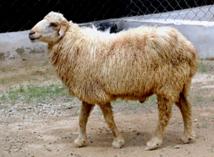 Magra ram
Magra ram Magra sheep has been improved for lustrous carpet wool production. This wool is in great demand from carpet industry because luster in carpet fetches higher price. First six monthly GFY and annual GFY are 0.95 and 2.20 kg, respectively. Wool quality traits of this breed are most suitable for a standard carpet. Fibre diameter (32.0 μ), staple length (5.15 cm) and medullation (40-45%) of this wool are most suitable for excellent carpet. Every year nearly 100 superior breeding rams are being supplied to farmers/Government agencies for genetic improvement in the animals in field.
Marwari, a robust sheep breed of arid zone

Marwari ram
Marwari is one of important carpet wool producing sheep breed of North Western arid and semi arid region of India. The breed is hardy and well adapted to harsh and erratic climatic conditions of hot arid region. This breed is considered to be largest in number and distributed widely in Rajasthan and some parts of Gujarat. The body weight at six month improved by 41.94 %
i.e. from 15.9 kg to 22.6 kg since the year 1993. The improvement (46%) in body weight at 12 month was from 20.8 kg to 30.4 kg. The adult annual GFY was improved from 1209 g to 1484 g (22.8 %) due to intensive selection and improved management of the sheep flock. The twining percentage was increased significantly due to better feeding and management practices followed at ARC Bikaner. The top ranked rams were selected and used in breeding to bring genetic improvement in the animals. A total of 981 superior breeding rams and 206 hogget males were supplied to the Government Agency/Farmers/ NGO/ Developmental agency since inception of Network Project.
North Temperate Regional Station (NTRS), Garsa, Himachal Pradesh
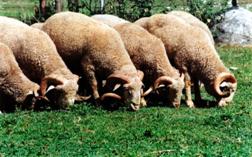 Gaddi Synthetic sheep
Gaddi Synthetic sheep
North Temperate Regional Station of CSWRI was started at Garsa, Kullu valley of Himachal Pradesh. This station is located at 1400-2100 meters above mean sea level on the right bank of Garsa stream. The centre is having a flock of 450 sheep.
The centre maintains the high quality germplasm of Gaddi Synthetic for improvement of sheep for fine wool production. The management practices and health calendar has been prepared for improving health and production performance both in stationary as well as in migratory flocks.
Southern Regional Research Centre (SRRC), Mannavanur, Tamil Nadu
Southern Regional Research Centre of CSWRI is located 35 Km from Kodai Kanal (Tamil Nadu). This centre is situated at an elevation of 2030 meters above mean sea level. The average annual rainfall is 1055 mm, well spread throughout the year. The centre is mandated to undertake research on fine wool sheep under temperate climate and having a flock of Bharat Merino sheep.
Bharat Merino: a fine wool producing sheep of India
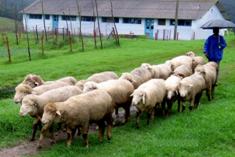 Bharat Merino Sheep
Bharat Merino Sheep
This fine wool crossbreed sheep was evolved by crossing halfbred ewes of Chokla, Nali, Malpura and Jaisalmeri with Rambouillet and/or Russian Merino rams and stabilizing the exotic inheritance at 75%. This breed is suitable for temperate and sub-temperate regions of the country and suitable for apparel wool production. Adult annual GFY is more than 2.5 kg with 19.38 m fibre diameter, less than 1 % medullation and 8 cm staple length.


